

It is probable that Hot Water Heating of Greenhouses/Glasshouses began to make an appearance towards the very end of George III’s reign and gradually became popular amongst those who could indulge in such a practice. The development of furnace-heated greenhouses (hothouses) can be traced back into the 18th century. In both instances it was often only the landed gentry who could afford to grow plants and fruit that benefitted from the greenhouse being heated by these methods. Apart from anything else the glass itself was very expensive, and it was not until the 1840s that ‘plate’ and ‘float’ glass was in invented and introduced. The Glass Tax was introduced in 1746 and taxed the raw materials used in glass making, glass back then being sold by weight. The Tax was abolished by Sir Robert Peel’s government in 1845.
We are, it is suggested, a nation of gardeners; indeed it is recorded in the Golden Hammer History of the Company that both the Kingdon brothers, Samuel and William, indulged in growing and exhibiting fruit and vegetables. With the Company having established a reputation for greenhouse heating one can assume both brothers had heated greenhouse systems installed by the firm’s hot water fitters at their respective properties, Sam at (the Old) Duryard House and William at Haccombe House – both properties now long gone.
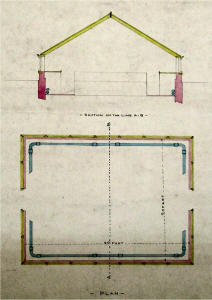 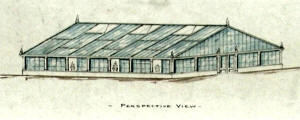 Plan and Perspective view of a heated greenhouse - no location or customer identified. Dimensions approximately 25ft x 20ft. |
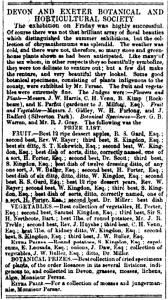 Exeter Flying Post report, 24th November 1853 |
The Exeter Flying Post records on the 24th November 1853 that the Devon & Exeter Botanical & Horticultural Society recognised both of their respective entries in the Fruit and Vegetable Sections and awarded prizes to both.
On the 28th July 1843 Garton & Jarvis, then at 25 North Street, placed an advertisement in the Exeter Flying Post and stated that
‘they had lately had the honour to erect the Newly Invented Boilers and Improved Hot Water Apparatus in her Majesty’s Gardens at Kew. Both on the Pipe and Rendles Tank System; and in addition to Royal Patronage they have received two orders from the learned Professor Lindley, for the London Horticultural Society, and from other learned Horticulturalists.’
They go on to say that they have erected more than twenty in Devonshire, mainly in the vicinity of Exeter and that one on the largest scale on the ‘Tank System’ is the New Propagating House at Messrs Veitch & Son’s Nursery. In 1841 The Gardeners’ Chronicle carried an article describing ‘Corbett's Hot-Water Apparatus’, a heating system using a Garton & Jarvis boiler installed at Cowley, Exeter (see the article).
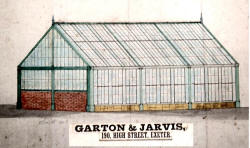 The drawing (right) is from the archives of a Greenhouse from the era of Garton & Jarvis. Unfortunately once again no details of the Customer or the Cost and in this instance no dimensions are given. The left end in the diagram is south facing.
The drawing (right) is from the archives of a Greenhouse from the era of Garton & Jarvis. Unfortunately once again no details of the Customer or the Cost and in this instance no dimensions are given. The left end in the diagram is south facing.
Both of the greenhouses shown here are what is called ‘Span House’ whilst any that are constructed against a wall are of the ‘Lean To’ variety.
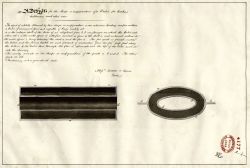 A drawing was submitted to the Design Office and registered on the 29th May 1859, also from the era when the business traded as Garton & Jarvis. It was allocated the serial No 4177 and was described as “The Design of the Configuration and Design of a Boiler for heating Hothouses and Other Uses” Its description can be read when clicked on to enlarge. Garton & Jarvis gained quite a reputation for Hothouse Heating as can be gleaned from this page and their successors, Garton & King continued to attract customers wishing to install Hothouse Heating within their greenhouses.
A drawing was submitted to the Design Office and registered on the 29th May 1859, also from the era when the business traded as Garton & Jarvis. It was allocated the serial No 4177 and was described as “The Design of the Configuration and Design of a Boiler for heating Hothouses and Other Uses” Its description can be read when clicked on to enlarge. Garton & Jarvis gained quite a reputation for Hothouse Heating as can be gleaned from this page and their successors, Garton & King continued to attract customers wishing to install Hothouse Heating within their greenhouses.
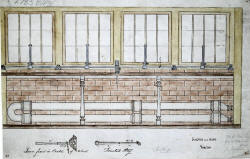 The diagram (right) shows not only a typical Hothouse manual window operating mechanism but also the cast iron stanchions supporting the seed bed and also the pipework for the hot water heating.
The diagram (right) shows not only a typical Hothouse manual window operating mechanism but also the cast iron stanchions supporting the seed bed and also the pipework for the hot water heating.
Even up to and beyond the 1920s the choice of 4” diameter pipework was considered to be the favoured radiating surface. The advantages of a goodly bulk of water in a horticultural apparatus is that it does not readily show any variations in the stoking. It is slow to heat and slow to cool, both are advantageous to the grower / gardener.
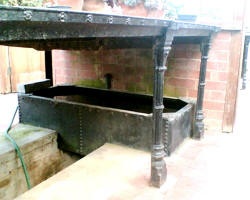 The photograph (far right) shows an example of a seed bed on cast iron stanchions at Halwill near Okehampton. It is uncertain whether the company installed this particular equipment or not but it connects well with the drawing.
The photograph (far right) shows an example of a seed bed on cast iron stanchions at Halwill near Okehampton. It is uncertain whether the company installed this particular equipment or not but it connects well with the drawing.
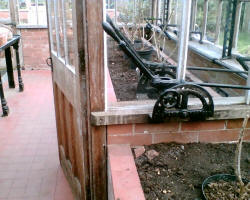 At the same establishment are examples of ‘real life’ window opening mechanisms. These were bought in and not produced by the company. Some examples at Shobrooke Park near Crediton exist, though the greenhouses are long gone; they give the manufacturer’s name as Geo. E. Saunders & Biss, Exeter.
At the same establishment are examples of ‘real life’ window opening mechanisms. These were bought in and not produced by the company. Some examples at Shobrooke Park near Crediton exist, though the greenhouses are long gone; they give the manufacturer’s name as Geo. E. Saunders & Biss, Exeter.
A good example of what might have been the company’s work is at Tregrehan House near Par in Cornwall. Whilst the proposed plans below (which show a Watermark of 1865) were not carried out as shown, it is still probable that the original Greenhouse was a product of the company.
Mr Tom Hudson of Tregreham comments:- “The plans show the new Pine Pits proposed at that estate. the main greenhouse range which is the bottom half of the plan was built around 1845 (and is largely the same today as in the plan, shown as existing prior to the G and K proposal). A new range was subsequently built where your plan shows new/alterations and works but not to the configuration that is indicated on the plan, in fact the pine pits were built (and are still there) in the north east corner of the plan, not where your proposal indicated which was in the north west part of the plan. Where the proposed pits were to have been built in the G and K proposals was built a house for stone fruit, and joined contiguously with the pinery in a single range with a glazed dividing section halfway along. This would include a new Boiler and other alterations to the existing Vineries, Greenhouses.”
Still on the subject of Tregrehan, we are able to show some of the 19th century Pipework installed in the Greenhouse. The greenhouse is still in use by Tom Hudson, the owner of Tregrehan, who provided the view from the outside (below left).
During the recent Covid pandemic a week of work was undertaken at Tregrehan to remove a mass of rubbish & rubble from the western boiler house. (extreme left in the drawing) which had accumulated over some 70 years. It probably included parts of the roof as that also had long gone. These next four photographs are courtesy of Tom Hudson, the owner. The depth of rubble and rubbish can be judged from the images. The end result was that a White Rose Boiler, made by Hartley & Sugden was found beneath everything and in remarkably complete condition. Liberably coated with used engine oil even the fire door is now able to be opened! Quite who installed this last boiler on the premises is not known for sure, you probably can realise my thoughts lean toward the family business!
Evidence is shown on the right that the Company did indeed act as Agents for Hartley & Sugden. This is a page from the Company Catalogue of 1900.
Next are an internal and external view of a somewhat overgrown and neglected greenhouse at the John Allen & Co’s Stowford Paper Mills, Ivybridge, Devon.
John Allen, who bought the existing paper making business in 1849, was a customer of Garton & Jarvis / Garton & King. It is more than possible that apart from involvement in supplying castings for the mill we may have had some involvement with the erection and heating of the Greenhouse. I visited the former Mill Garden in 2014, you could see the remains of the external Boiler House. The interior of the greenhouse was very much in a shambolic and fragile state and entering it would have been a somewhat foolhardy thing to do.
These photos are from a collection kindly provided by the Ivybridge History and Archives Group, which show that Mill Garden once had several other heated greenhouses with an extensive heating system. The three photos below show some remaining heating pipework and the boiler.
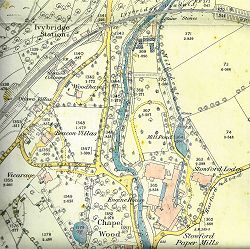 There is ample evidence that John Allen of Stowford Mill engaged Garton & King to install Hothouse Heating and it is perhaps of interest to the reader to learn about the use that the walled Garden at Stowford was put to in the period 1911 to about 1917. The map, dated 1887, shows not only the location of the Mill Complex as well as the Lodge but also, to the north, the Walled Garden and glasshouses.
There is ample evidence that John Allen of Stowford Mill engaged Garton & King to install Hothouse Heating and it is perhaps of interest to the reader to learn about the use that the walled Garden at Stowford was put to in the period 1911 to about 1917. The map, dated 1887, shows not only the location of the Mill Complex as well as the Lodge but also, to the north, the Walled Garden and glasshouses.
The information that follows has been sourced from the Devon Garden’s Trust.
The Devon School of Gardening (for women) was set up in the walled kitchen garden at Stowford Mill by May Crooke F.R.H.S. and Mabel Carlyon in 1911. Although the School closed in 1917, it is important as it was one of the few horticultural schools for women. May Crooke was one of the first students of the Lady Warwick Hostel, set up by Lady Warwick the mistress of the Prince of Wales, one of the first horticultural colleges for women in the country. The Devon School was aimed at middle class women and helped train them to run estates and smallholdings during the first World War. The garden contained 10 glasshouses, a variety of trees and extensive lawns and flower gardens. The school catered for young ladies who wished to study horticulture and gave practical and theoretical instruction. The aim of the school was to ‘turn out women capable of filling some of the many posts offered, or returning to their own Estates and Gardens, and working them to the very best advantage’
The sign board near the top right of the black & white image (below left) reads ‘The Devonshire School of Gardening.’ The south easterly view is similar to that a passenger could experience from a passing train high up on the viaduct (marked on the map.)
The central image below is a page from ‘The Sphere’ magazine dated 15th February 1913 featuring the Devonshire School of Gardening.
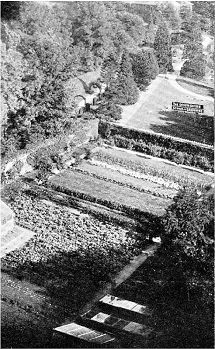 Stowford Mill Garden, view looking south-eastwards from the north |
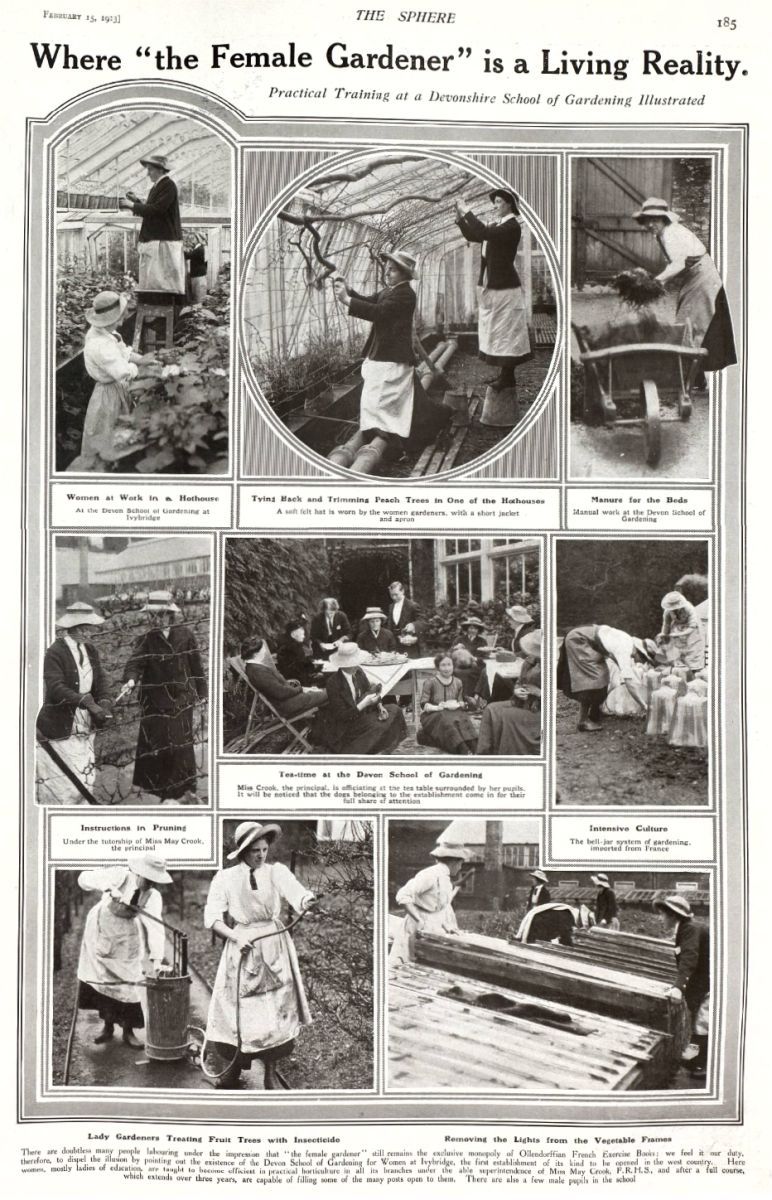 The Devonshire School of Gardening Full page from ‘The Sphere’ 1913 |
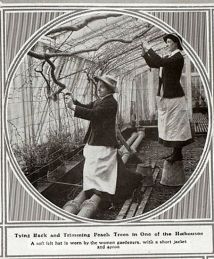 One illustration from ‘The Sphere’ page |
The illustration (above right) from the top of the ‘Sphere’ page shows women at work in one of the Greenhouses in the School of Gardening. Note the large diameter pipes that provided heat. The Advert below is from the Western Morning News dated the 13th May1911.
Regrettably many of the locations where the company installed heating work in horticultural buildings or where they constructed Greenhouses have not survived. The plan shown below for heating and improvements to Cucumber and Melon Pits at John Bulted Esq’s Pamflete House is the only real evidence of the work performed.
At Pamflete, the base of the vinery / melon & cucumber pits still survives as red brick, with raised beds and possibly still the pipework. The western end of the greenhouse – the lefthand bit on the plan – had a glass roof put on it, in about the late 80s maybe. The remainder is open to the elements.
Recorded in another scale drawing was work that was carried out to the heating and the replacement of the boiler at the former Vinery and Peach House at Empacombe for the Rt. Hon. Earl of Mnt. Edgcumbe in November 1873. It is unlikely that much evidence of that work still exists.
There are many places within Devon and the Westcountry that had Green / Hothouses that were constructed by the Company but often as not they no longer exist or the heating equipment and piping has been removed. Particularly valued customers were the owners of Holcombe Court, Holcombe Rogus. Owned by the Bluett family until sold to the Rev. William Rayer in 1858. The plans of the Greenhouse are shown, but it too no longer exists. They date from the era of the Rev Raye’s ownership which commenced in 1858 and the estate passed on through family until the last of the Rayers died in 1936. It then passed through various hands until purchased by the present owner in 2001.
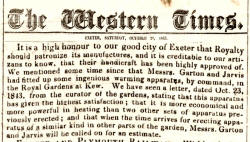 An article appeared in the Western Times on the 28th October 1843 which mentions the involvement of Garton & Jarvis and the excellent performance of the Heating Appliance, a Circular Boiler, installed at the Royal Gardens at Kew, London. At that time there were three boilers installed, only the Garton and Jarvis boiler was commended, the other two not supplied by G & J lacking economy and heating power.
An article appeared in the Western Times on the 28th October 1843 which mentions the involvement of Garton & Jarvis and the excellent performance of the Heating Appliance, a Circular Boiler, installed at the Royal Gardens at Kew, London. At that time there were three boilers installed, only the Garton and Jarvis boiler was commended, the other two not supplied by G & J lacking economy and heating power.
The photograph below left (Courtesy & Copyright Caradoc Doy.) is of James Veitch & Sons Nursery in Chelsea, London. The company performed much work both at Chelsea and also Veitch’s Nursery in Exeter (below right). Although the tinted postcard looking towards the Miles Memorial Clock Tower in Exeter should really be posted on the ‘Iron Gates’ page it does show a view of the Gates to the Veitch Nursey on New North Road. These gates were manufactured, need I say, by the Company.
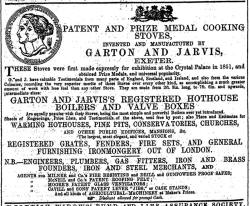 This Garton & Jarvis’s Advert of July 1860 promotes the Company’s Hothouse Boilers. There’s also a spelling mistake in the text in Capital Letters – can you see it? Answer at the bottom of this page!
This Garton & Jarvis’s Advert of July 1860 promotes the Company’s Hothouse Boilers. There’s also a spelling mistake in the text in Capital Letters – can you see it? Answer at the bottom of this page!
‘Garden Establishments’ on the Customers page lists some fifty or more establishments as customers of the Company. Many of the entries now have images attached and often there is a glimpse of a conservatory or greenhouse to be seen. Practically every large estate or mansion had a large greenhouse in those Victorian times and some survive to this day. Most properties open to the public, often National Trust, still retain these structures as the larger estates had walled gardens, the staff level in the 18th & 19th centuries was high and the gentry were usually able to lavish money on creating Vine, Cucumber, Melon Pits, Camelia Houses and Heated Greenhouses, and Garton & Jarvis and its successor Garton & King certainly were successful in tapping that market. After all, if you had high approval from The Royal Gardens at Kew (see the Western Times Article of 1843, above), what more in terms of recommendation do you need?
Solution:- MANUFACTUTED !
Updated April 2022
Top of page
See also:
Golden Hammer
Corbett’s Hot-Water Apparatus
Heating Equipment — The Mixed Bag Page
Customers — 144 Years of Newspaper Adverts
Sitemap / Contents